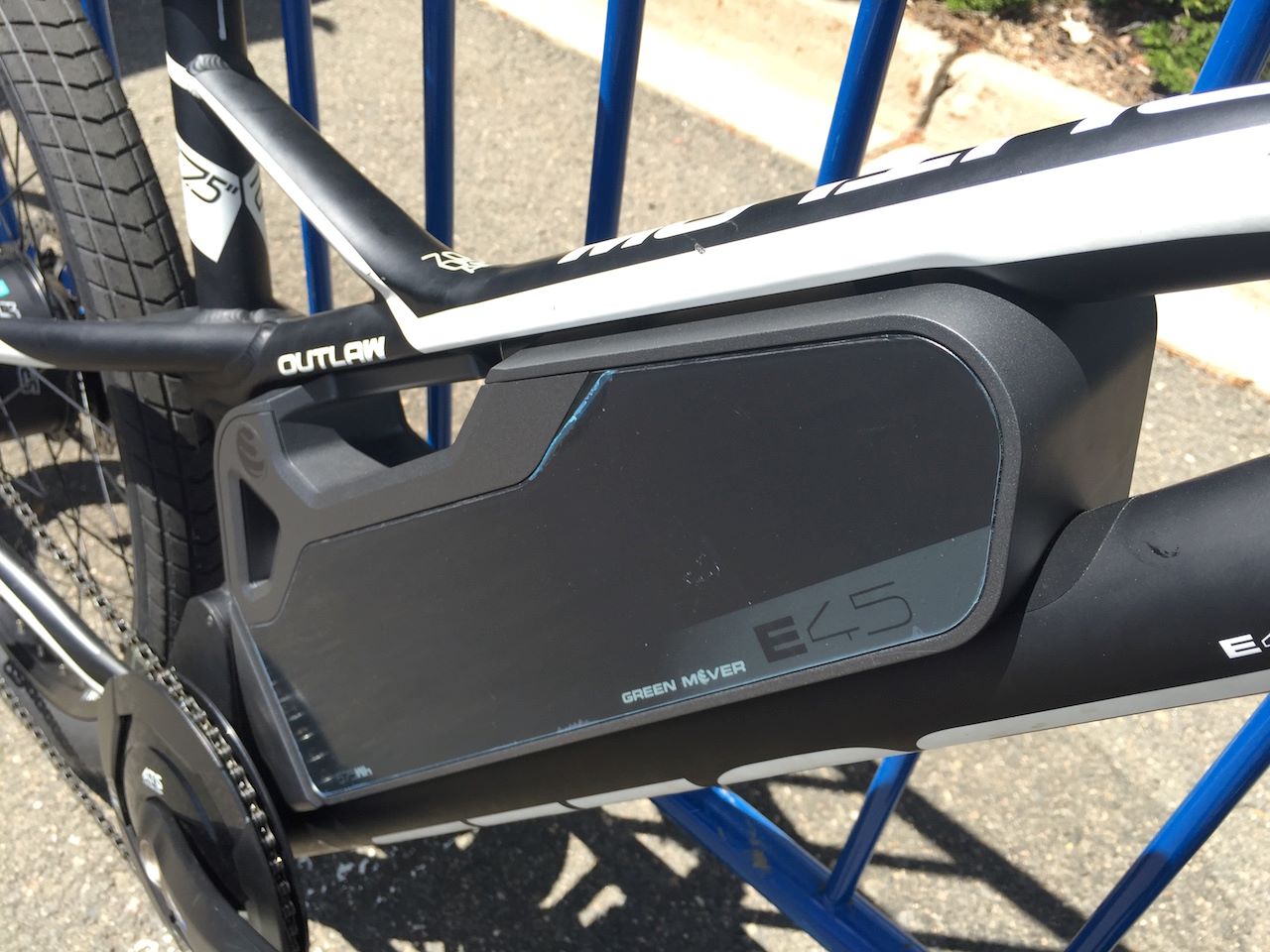

Articles
How To Store Electric Bike Batteries
Modified: December 7, 2023
Looking for articles on how to store electric bike batteries? Discover effective tips and techniques to protect and extend the lifespan of your e-bike battery.
(Many of the links in this article redirect to a specific reviewed product. Your purchase of these products through affiliate links helps to generate commission for Storables.com, at no extra cost. Learn more)
Introduction
Electric bikes have become increasingly popular for their eco-friendly nature and convenience. One of the key components of an electric bike is the battery, which provides the power needed to propel the bike forward. However, there may be occasions when you need to store your electric bike and its battery for an extended period of time, such as during the winter months or when going on a long vacation.
Properly storing your electric bike battery is essential to maintain its performance and prolong its lifespan. In this article, we will guide you through the process of storing your electric bike battery correctly, ensuring that it remains in optimal condition for future use.
Key Takeaways:
- Properly storing your electric bike battery is crucial for maintaining its performance and longevity. Choose the right storage location, prepare the battery, and store it in a cool, dry environment to ensure optimal condition for future use.
- Regularly checking on the battery during storage and following maintenance tips such as periodic recharging and temperature regulation are essential for prolonging the lifespan and performance of your electric bike battery.
Read more: How To Store An eBike Battery
Choosing the Right Storage Location
When it comes to storing your electric bike battery, the first step is to find the right storage location. The ideal storage location should be cool, dry, and well-ventilated. You want to avoid extreme temperatures, as they can have a negative impact on the battery’s performance and longevity.
Avoid storing your electric bike battery in areas that are prone to high temperatures, such as near heating vents or in direct sunlight. Similarly, extremely cold temperatures can also be harmful to the battery. It’s best to choose a storage location where the temperature remains relatively stable.
In addition to temperature considerations, it’s important to keep the battery away from sources of moisture and humidity. Moisture can lead to corrosion and damage to the battery and its connectors. Choose a place that is free from any potential water leaks or humidity buildup.
Furthermore, it’s advisable to select a storage location that is well-ventilated. Good air circulation will prevent the buildup of any gases or fumes that may be released by the battery during storage.
Overall, when choosing the right storage location, prioritize coolness, dryness, and proper ventilation to ensure the optimal condition of your electric bike battery.
Preparing the Battery for Storage
Before storing your electric bike battery, it’s important to properly prepare it to ensure its longevity. Follow these steps to prepare your battery for storage:
- Charge the battery: Before storing the battery, make sure it is fully charged. This helps to prevent any self-discharge and maintains the battery cells’ health during storage. Use the charger provided by the manufacturer and allow the battery to reach full capacity.
- Disconnect the battery: Once the battery is fully charged, disconnect it from the electric bike by following the manufacturer’s instructions. This ensures that the battery doesn’t drain any power while in storage.
- Check battery voltage: Use a voltmeter to check the battery’s voltage. Ideally, the voltage should be around 50-70% of the battery’s total capacity. This level of charge helps to prolong the battery’s lifespan during storage.
- Remove any accessories: If your battery has any accessories such as a battery bag or cover, it’s recommended to remove them before storing. This allows for better air circulation and prevents any potential damage to the accessories during storage.
- Secure the battery: Ensure that the battery is properly secured in a stable position to prevent any unnecessary movement or damage during storage. Use foam or cushioning materials to keep the battery in place and protect it from any potential impacts or vibrations.
By following these steps, you can prepare your electric bike battery for storage and ensure that it remains in optimal condition until you’re ready to use it again.
Removing the Battery from the Electric Bike
Once the battery is fully charged and prepared for storage, the next step is to remove it from the electric bike. This step is crucial to prevent any power drainage and ensure the safety of the battery during storage. Follow these steps to remove the battery:
- Consult the user manual: Before removing the battery, refer to the user manual provided by the electric bike manufacturer. Each bike model may have specific instructions for removing the battery.
- Locate the battery compartment: Identify the location of the battery compartment on your electric bike. In most cases, it will be located on the frame of the bike, often near the downtube or rear rack.
- Turn off the bike: Make sure the electric bike is turned off before attempting to remove the battery. This ensures the safety of the battery and prevents any accidental electrical discharge.
- Disconnect the battery: Once the bike is turned off, locate the connectors on the battery and carefully disconnect them. Some batteries may have additional security mechanisms, such as locks or release buttons, which need to be disengaged before disconnecting the battery.
- Gently remove the battery: With the connectors disconnected, gently slide or lift the battery out of the compartment. Be careful to avoid any unnecessary force or damage to the battery or the bike.
Once the battery is successfully removed from the electric bike, proceed to the next step of cleaning and inspecting the battery before storing it. Properly removing the battery ensures its safety and minimizes the risk of any damage during storage.
Cleaning and Inspecting the Battery
Before storing your electric bike battery, it’s essential to clean and inspect it to ensure that it remains in optimal condition. Follow these steps to clean and inspect your battery:
- Clean the exterior: Use a soft, dry cloth to gently wipe down the exterior surfaces of the battery. This removes any dirt, dust, or debris that may have accumulated. Avoid using water or any cleaning solvents, as they can damage the battery.
- Inspect for damage: Carefully examine the battery for any signs of damage, such as cracks, dents, or bulges. Additionally, inspect the battery connectors for any corrosion or loose wires. If you notice any significant damage, it’s best to consult the manufacturer or a professional for further guidance.
- Check the battery contacts: Inspect the battery contacts to ensure they are clean and free from corrosion. If you notice any buildup or corrosion, use a cotton swab lightly dampened with alcohol to gently clean the contacts. Allow the contacts to dry completely before proceeding.
- Inspect the wiring: Check the wiring connected to the battery for any signs of wear or fraying. If you notice any damaged or exposed wires, it’s recommended to have them repaired or replaced before storing the battery.
- Inspect the battery management system (BMS): If your battery has a built-in BMS, ensure that it’s functioning properly. The BMS helps to regulate the battery’s charging and discharging, as well as monitor its temperature and voltage levels. If you suspect any issues with the BMS, consult the manufacturer for assistance.
By thoroughly cleaning and inspecting your electric bike battery, you can identify any potential issues and address them before storing the battery. This ensures the longevity and safety of the battery during storage and future use.
When storing electric bike batteries, it’s important to keep them in a cool, dry place and at a partial state of charge (around 50%). Avoid extreme temperatures and store them away from direct sunlight.
Read more: How To Store An Electric Bike
Charging the Battery
Before storing your electric bike battery, it’s important to charge it fully to maintain its health and performance during storage. Follow these steps to properly charge your battery:
- Use the manufacturer’s charger: It’s always recommended to use the charger provided by the manufacturer to ensure compatibility and optimal charging performance.
- Connect the charger: Plug the charger into a power outlet and connect it to the battery. Ensure that the connectors are securely fitted and properly aligned.
- Monitor the charging process: Once the charger is connected, it will start charging the battery. Monitor the charging process and ensure that it progresses smoothly without any interruptions or abnormalities.
- Allow for sufficient charging time: Different batteries may require different charging times. Refer to the manufacturer’s guidelines to determine the appropriate charging duration for your specific battery model. Avoid overcharging the battery, as it can lead to damage.
- Check the charging indicator: Many chargers have a charging indicator that shows the progress of the charging process. Once the battery is fully charged, the indicator will typically show a solid light or change color to indicate completion.
- Disconnect the charger: After the battery is fully charged, disconnect the charger from the power outlet and the battery. Ensure that you properly unplug and store the charger in a safe place.
- Check the battery voltage: Use a voltmeter to check the battery’s voltage after charging. It should be at or near its full capacity. This confirms that the battery is fully charged and ready for storage.
By following these steps and ensuring that your electric bike battery is fully charged, you can maintain its health and readiness for future use during the storage period.
Storing the Battery in a Cool and Dry Environment
Choosing the right storage environment for your electric bike battery is crucial to maintain its performance and longevity. Here’s how to store the battery in a cool and dry environment:
- Select a suitable storage container: Look for a container that is specifically designed for battery storage. It should be well-ventilated and made of non-conductive material to prevent any potential electrical discharge.
- Place the battery in the container: Carefully place the battery in the container, ensuring that it is stable and secure. Avoid placing any items on top of the battery or applying pressure that could cause damage.
- Store the battery in a cool location: Find a storage area with a stable temperature that doesn’t experience extreme heat or cold fluctuations. High temperatures can degrade the battery, while low temperatures can affect its performance.
- Avoid moisture and humidity: Keep the storage environment dry to prevent any moisture accumulation. Moisture can lead to corrosion and damage the battery. If necessary, use desiccant packs or silica gel to absorb any excess moisture.
- Avoid direct sunlight: Keep the storage container away from direct sunlight or any other intense sources of light. Prolonged exposure to sunlight can affect the battery’s performance and capacity.
- Store in a well-ventilated area: Ensure that the storage area has proper ventilation to prevent the buildup of any gases or fumes that may be emitted by the battery.
Remember to label the storage container with the battery’s information, such as the date of storage and any maintenance or charging instructions, for future reference.
By storing your electric bike battery in a cool and dry environment, you can protect it from potential damage and ensure that it remains in optimal condition until you’re ready to use it again.
Checking on the Battery During Storage
While your electric bike battery is in storage, it’s important to periodically check on it to ensure its well-being and prevent any issues that may arise. Here are some guidelines for checking on the battery:
- Regular inspection: Set a schedule to inspect the battery at regular intervals, such as once a month or every few weeks. This allows you to catch any potential problems early.
- Visual inspection: Examine the battery for any physical damage, such as cracks, bulges, or leaks. If you notice any abnormalities, it’s best to consult the manufacturer or a professional for further guidance.
- Check the terminal connections: Ensure that the battery terminals are clean and free from any corrosion or debris. If necessary, gently clean the terminals with a soft cloth or a specialized battery terminal cleaner.
- Test the voltage: Use a voltmeter to check the battery’s voltage during the inspection. This helps you determine if the battery has retained its charge or if it needs to be recharged. Refer to the manufacturer’s guidelines for the appropriate voltage range.
- Ensure proper storage conditions: Verify that the storage container remains in a cool, dry, and well-ventilated environment. Check for any signs of moisture buildup or extreme temperature fluctuations.
- Inspect the charging port: If your battery has a charging port, ensure that it is clean and not obstructed. This allows for smooth and easy charging when you’re ready to use the battery again.
By regularly checking on your electric bike battery during storage, you can address any issues promptly and ensure that the battery remains in good health. This proactive approach helps to prolong its lifespan and maintain its performance for future use.
Maintenance Tips for Long-Term Battery Storage
Proper maintenance is essential for ensuring the longevity and performance of your electric bike battery during long-term storage. Follow these tips to maintain your battery while it’s not in use:
- Keep the battery charged: It’s important to periodically recharge the battery, even when it’s not in use. Aim to recharge the battery at least once every three months to prevent it from fully discharging and entering a dormant state.
- Store at the optimal temperature: Maintain the storage environment within the temperature range recommended by the manufacturer. Extreme temperatures can negatively impact the battery’s performance and lifespan. If possible, store the battery in a temperature-controlled area or use insulation materials to regulate temperature fluctuations.
- Avoid overcharging: While it’s important to keep the battery charged, avoid overcharging it. Once the battery reaches its full charge, unplug it from the charger to prevent any potential damage due to overcharging.
- Use a battery maintainer: Consider using a battery maintainer or a trickle charger specifically designed for storing batteries. These devices can help maintain the battery’s charge and prevent it from fully discharging during storage.
- Keep the battery clean: Periodically clean the battery’s exterior with a soft cloth to remove any dust or dirt. Avoid using water or harsh chemicals, as they can damage the battery. Additionally, ensure that the battery contacts remain clean and free from corrosion.
- Rotate the battery position: If possible, rotate the battery’s position during storage. This helps to distribute any potential weight or pressure evenly and prevents the battery from developing flat spots.
- Follow the manufacturer’s guidelines: Always refer to the manufacturer’s instructions and recommendations for storing your specific electric bike battery model. They may provide specific guidelines or precautions that are important to follow for optimum battery maintenance.
By following these maintenance tips, you can ensure that your electric bike battery remains in good condition throughout its storage period and retains its performance when you’re ready to use it again.
Read more: How To Store E-Bike Battery For Winter
Conclusion
Properly storing your electric bike battery is essential to maintain its performance and longevity. By following the steps outlined in this article, you can ensure that your battery remains in optimal condition during storage and is ready for future use.
Start by choosing the right storage location that is cool, dry, and well-ventilated. Prepare the battery by fully charging it, disconnecting it from the electric bike, and inspecting it for any damage. Clean the battery carefully and remove any accessories before storing it.
When it comes to storing the battery, select a suitable container and store it in a cool and dry environment. Avoid exposure to extreme temperatures, direct sunlight, moisture, and excessive humidity. Regularly check on the battery during storage to ensure its well-being and address any issues early on.
Remember to maintain the battery’s charge by periodically recharging it, and store it within the recommended temperature range. Follow the manufacturer’s guidelines and use specialized equipment such as battery maintainers or trickle chargers if necessary.
With proper maintenance and storage, your electric bike battery will remain in optimal condition, prolonging its lifespan and ensuring its readiness for future use. By taking the time to care for your battery, you can maximize its performance and enjoy your electric bike adventures for years to come.
Frequently Asked Questions about How To Store Electric Bike Batteries
Was this page helpful?
At Storables.com, we guarantee accurate and reliable information. Our content, validated by Expert Board Contributors, is crafted following stringent Editorial Policies. We're committed to providing you with well-researched, expert-backed insights for all your informational needs.














0 thoughts on “How To Store Electric Bike Batteries”